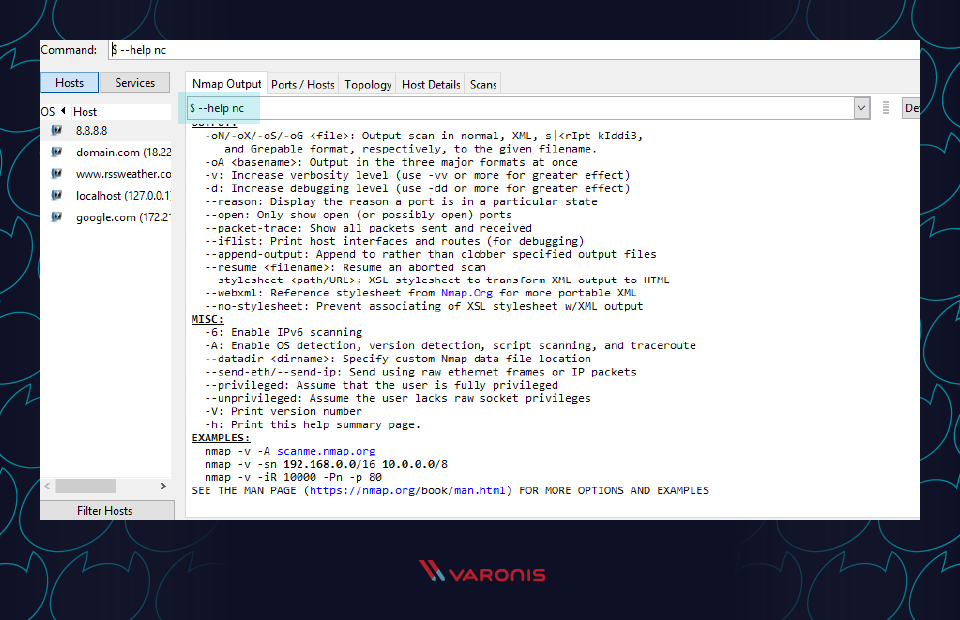
In general, a destination port must be specified, unless the -U option is given (in which case a socket must be specified). In general, a hostname must be specified, unless the -l option is given (in which case the local host is used). Hostname can be a numerical IP address or a symbolic hostname (unless the -n option is given). z Just scan for listening daemons, without sending any data to them. Protocol is used (1080 for SOCKS, 3128 for HTTPS). If port is not specified, the well-known port for the proxy Is not specified, SOCKS version 5 is used.Ĭonnect to hostname using a proxy at proxy_address and port. '5' (SOCKS v.5) and 'connect' (HTTPS proxy). Requests that nc should use the specified protocol when talking The -w flag has noĮffect on the -l option, i.e. If a connection and stdin are idle for more than timeout seconds, u Use UDP instead of the default option of TCP. This makes it possible to use nc to script telnet sessions.

t Send RFC 854 DON'T and WON'T responses to RFC 854 DO and WILL requests. It is an error to use this option in conjunction with the -l option. The IP of the interface which is used to send the packets.

Sequentially within a range or in the order that the system assigns them. r Select the source and/or destination ports randomly instead of Specify the source port nc should use, subject to privilege n Skip all DNS or service lookups on addresses, hostnames or ports. Peer is not reachable and generating an adpative timeout Number of probes to send to the peer before declaring that the It is an error to use this option in conjunctionĪdditionally, any timeouts specified with the -w option are ignored. l Listen for an incoming connection rather than initiate a connection k Force nc to stay listening for another connection after its currentĬonnection is completed. Number of times to repeat TCP keep alive packets. Interval for repeating TCP keep alive timeouts in seconds. Initial TCP keep alive timeout in seconds. Specifies a delay time interval between lines of text sent and received.Īlso causes a delay time between connections to multiple ports. This will prevent any text being sent from a client to the server. C Force nc not to use cellular data context. I should mention ncat (coded by the author of nmap), which is a rewrite of netcat.Read and write data across networks - arbitrary TCP and UDP connections and listens. NC can be used for anything and it's so simple and easy to use! Netcat-1.12 -e (ctrl+c terminate cmd.exe)Īmazing program. This is a very powerful tools for network security detection I'd ever used. Use this tool when you need to know for sure what a port is communicating back to you. It retains all of the old functionality and adds several nice features such as group chatting complete with a server.

The venerable nc relives as ncat and this is a serious update. and the one i like most is the backdooring capabilities I have seen some people having issues with nc6. Do you guys use it also in IPv6 networks? I know about the v6 version (nc6) but I'm not sure how stable it is in IPv6 cases. I have been using netcat for ages and works great in IPv4 environments. The tool is "old" and simple, but still is actual and useful. Very cool tool for linux administration & pentesting issues. Thanks to dev it's a very good tool ! Can be used on alls Windows, 7,8,10 :) Long live netcat! One that swiss knife is the best. Other takes on this classic tool include the amazingly versatile Socat, OpenBSD's nc, Cryptcat, Netcat6, pnetcat, SBD, and so-called GNU Netcat. The flexibility and usefulness of this tool prompted the Nmap Project to produce Ncat, a modern reimplementation which supports SSL, IPv6, SOCKS and http proxies, connection brokering, and more. It can sometimes even be hard to find a copy of the v1.10 source code. The original Netcat was released by Hobbit in 1995, but it hasn't been maintained despite its popularity. At the same time, it is a feature-rich network debugging and exploration tool, since it can create almost any kind of connection you would need, including port binding to accept incoming connections. It is designed to be a reliable back-end tool to use directly or easily drive by other programs and scripts. This simple utility reads and writes data across TCP or UDP network connections.


 0 kommentar(er)
0 kommentar(er)
